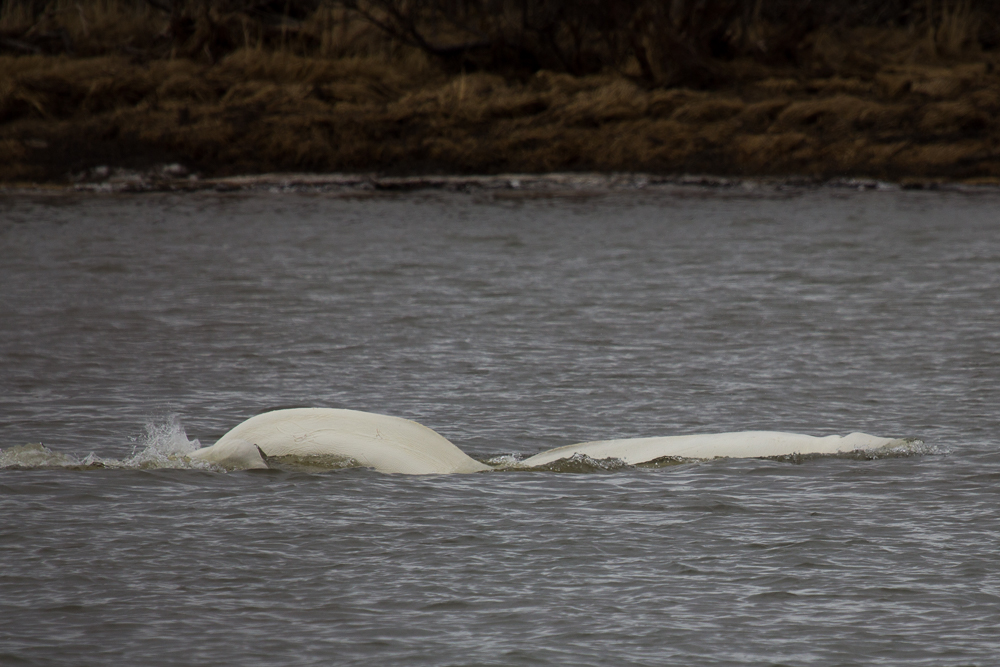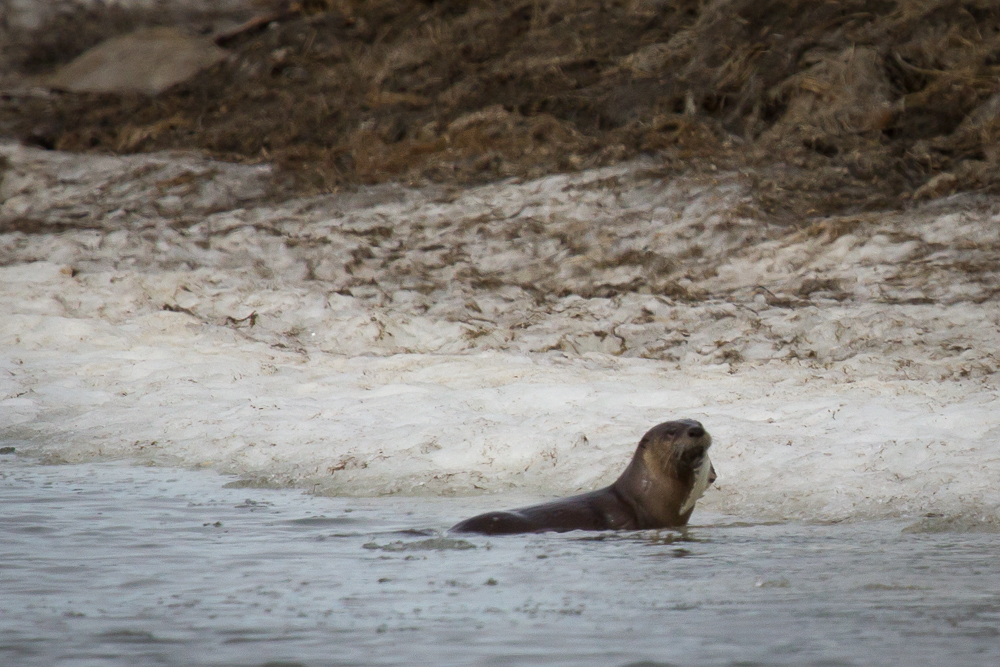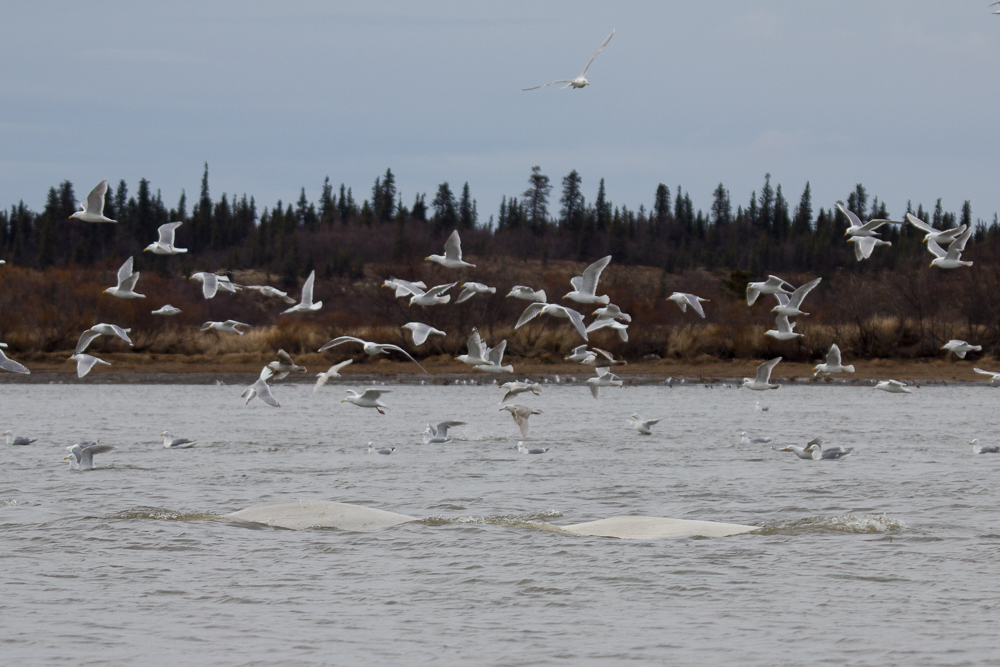Alaska is a last refuge for wildlife that once roamed all of North America. Bears, wolves, moose and others draw visitors from around the world to watch in awe. Others are less conspicuous. Counter to romanced visions of the last frontier, some of Alaska’s most elusive inhabitants live not in the remote, untrammeled tundra and boreal forests, but just beneath its murky coastal waters and estuaries – surprisingly close to its human populations.
Each spring in King Salmon, just outside the borders of Katmai National Park, beluga whales travel from the nearshore waters of Bristol Bay up the Naknek River, riding the incoming tide to follow a seasonal availability of rainbow smelt. For those who choose to observe them, the belugas brief appearance in the close quarters of the Naknek River offer a rare and valuable glimpse at a mysterious, little-studied creature.
 Three beluga whales surface to breath; the rear whale's head is partially visible. Photo by D. Kopshever
Three beluga whales surface to breath; the rear whale's head is partially visible. Photo by D. Kopshever
Like bats, belugas use echolocation to navigate the dark, silty waters of the Naknek river, and to locate fish and other prey. Highly social animals, belugas often hunt and interact in groups of a few to several hundred. Although they are only visible for brief moments as they snorkel at the surface to breathe, observers can sometimes see their social interactions on display – a pectoral fin waving in the air, a coordinated attack to trap a school of smelt, or a game of chase between two juveniles. All the while they produce a multitude of clicks, moos, squeaks, and various other noises unrivaled in diversity from all other cetaceans. While it’s known that these vocalizations are used for communication of some form, they have not been studied intensely like those of bottlenose dolphins or humpback whales. The extent of impact that human-generated noise has on beluga whales’ ability to communicate, hunt, and survive remains unclear.
As the belugas travel up Naknek River, hungry opportunists tag along. Clouds of gulls hover and dive-bomb frenzied schools of fish. Harbor seals, river otters and other shorebirds bring up the rear, capitalizing on the leftovers. Off-duty rangers watching in King Salmon estimated nearly 200 individuals passing by on the busiest mornings. These large pods form temporarily to feed on spawning rainbow smelt moving upriver, and salmon smolt traveling out to sea.

Hundreds, even thousands of gulls stick closely to the traveling belugas, diving in for fish pushed to the top of the water. Photo by A. Ramos.
 A river otter eats his catch on shore, before returning to follow belugas and their cornered schools of fish. Photo by A. Ramos.
A river otter eats his catch on shore, before returning to follow belugas and their cornered schools of fish. Photo by A. Ramos.
A recent study by the National Oceanic and Atmospheric Administration (NOAA) compared the stomach contents of 365 beluga whales from different stocks around Alaska, collected between 1954 and 2012. The study showed significant variations in diet between different stocks, with belugas farther to the north in the Beaufort Sea eating mostly shrimp, octopus, and arctic cod, while Bristol Bay stocks were found to eat primarily adult salmon, salmon smolt, and rainbow smelt. Beluga bellies also held small amounts of 22 additional fish species. Stomach contents were collected between March and November for all stocks, with no collections taking place during winter months. To date, belugas’ winter feeding habits remain a mystery.
 Belugas surface for air while gulls hover overhead. Photo by Anela Ramos.
Belugas surface for air while gulls hover overhead. Photo by Anela Ramos.
Beluga whales hold another big secret: their age. Like other cetaceans, beluga whales are aged according to Growth Layer Groups (GLG’s) in their teeth, much like counting the rings of a tree. Scientists have yet to determine though, how many layers are created with each passing year. Recent studies (http://www.north-slope.org/assets/images/uploads/Lockyer_et_al_beluga_aging.pdf) have been inconclusive, but suggest that belugas may produce one GLG per year as opposed to two, meaning they might live twice as long as previously thought, perhaps 70 years or older in the wild.
As we continue to study and observe beluga whales, we reinvent our understanding of how they live and survive in the wild. Keep track of the Naknek River tides near King Salmon, and tune in to the Naknek River cam on Explore.org one to two hours before the first high tide of each day, from late March to early May. There’s no telling what we might learn from watching these mysterious creatures as they live out their lives, just beyond the shores of Alaska’s cities and towns.
Read more about beluga whales in Bristol Bay here.
|
May 01, 2017
|
Last updated: May 1, 2017
